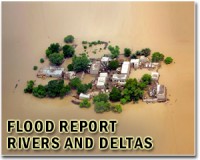| . |  |
. |
Manila (AFP) Oct 26, 2009 More than 1.5 million people are struggling to live in flooded suburbs or crowded shelters one month after devastating rains began pounding the Philippines, and officials warn no quick fix is in sight. The impoverished Southeast Asian nation faces a huge long-term battle to recover from the two storms that claimed at least 929 lives in Manila and other parts of the main Luzon island, the government and relief organisations said. "The storms and torrential rains... have left the people of the Philippines facing one of the greatest challenges in memory," the UN's World Food Programme director, Josette Sheeran, said during a weekend visit to Manila. After tropical storm Ketsana dumped the heaviest rains in more than 40 years on Manila on September 26, entire districts remain waist-deep in water and piles of flood debris still litter other parts of the capital. In mountainous areas of northern Luzon that were pummelled by 10 days of torrential rain from tropical storm Parma which arrived a week later, villages remain ghost towns after being hit by landslides. The World Health Organisation says 1.43 million people, mostly in and around Manila, continue to endure a dangerous existence living in flooded districts. Those areas may remain flooded for months because chaotic urban planning has led to natural drainage systems along lakes being blocked. Already 175 people have died in those areas from leptospirosis, a bacterial disease that is contracted from contact with flood waters contaminated with rat and cat urine. "The solution is to get them out of these places," Art Pesigan, an official with the WHO's emergency and humanitarian action unit, told AFP, referring to those living in the flood waters. Another 163,000 people who lost their homes in the disasters remain in evacuation centres, according to the government, with few options but to stay there and rely on handouts. The government, which has repeatedly said it is not able to cope with the twin disasters on its own, has appealed for international help. But although foreign governments and international aid agencies have provided crucial aid, less than a third of a UN appeal for 74 million dollars has been raised. Amid the immediate relief concerns, the government is also having to grapple with longer-term reconstruction efforts. One of the main concerns is that too many people, particularly slum dwellers, in Manila have been allowed to live in flood-prone areas. A government report last week called for 2.7 million people in shantytowns to be moved from "danger zones" alongside riverbanks, lakes and sewers. The plan would affect one in five Manila residents and take 10 years and 130 billion pesos (2.77 billion dollars) to implement. Economic migrants who flocked Manila's teeming shantytowns are being offered free bus fares back to their abandoned farms. But the government said just 300 families had taken up the offer, illustrating what critics say is an inept government approach to dealing with the long-term problems that exacerbated the disasters. Richard Gordon, an opposition senator who also heads the Philippine branch of the Red Cross, told AFP the government needed to do more than "the stop-gap measures" announced so far. He agreed there had to be an effort to move people away from vulnerable areas in Manila and elsewhere, but said a much broader perspective to the problem needed to be taken. "The trick is to find new areas to put these people in, places safe from floods and landslides, but at the same time accessible to jobs and schools," he said. Gordon suggested giving tax breaks and other incentives to lure businesses to new industrial zones in areas where there is already good infrastructure, such as the former US military bases at Clark and Subic Bay. Share This Article With Planet Earth
Related Links Bringing Order To A World Of Disasters When the Earth Quakes A world of storm and tempest
 UN predicts flash floods in parched East Africa
UN predicts flash floods in parched East AfricaGeneva (AFP) Oct 20, 2009 The UN warned on Tuesday that flash floods could hit East Africa over the coming months and deal a devastating blow to hundreds of thousands of people who are already reeling from severe drought. The UN's humanitarian coordination office predicted that the El Nino climate pattern in the Pacific basin could trigger heavy rain in the Horn of Africa after the region was hit one of the worst ... read more |
|
| The content herein, unless otherwise known to be public domain, are Copyright 1995-2009 - SpaceDaily. AFP and UPI Wire Stories are copyright Agence France-Presse and United Press International. ESA Portal Reports are copyright European Space Agency. All NASA sourced material is public domain. Additional copyrights may apply in whole or part to other bona fide parties. Advertising does not imply endorsement,agreement or approval of any opinions, statements or information provided by SpaceDaily on any Web page published or hosted by SpaceDaily. Privacy Statement |